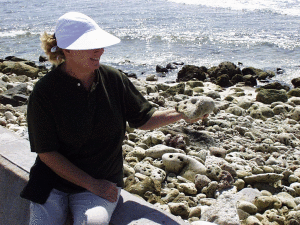I am one of the rare people who like to move. I like sorting stuff. I like throwing stuff away. I like having new, clean space to fill with things I need rather than things I might need someday. I like traveling for the same reason. There is serenity in having everything you need in a suitcase or two. When my husband and I headed off to live for a year on an island in Maldives, we took two suitcases each. Okay. I also packed a box of research books that I shipped. They traveled the world then landed back on my front walk months later when they couldn’t find me. I managed to write the book without them. We returned home ourselves fourteen months later with everything we owned in the same suitcases, having bought a few things and thrown out others.
This week I’m taking the trash bag and heading into the manuscript that is set in Maldives. It came in at 50,000 words — a little long for middle grade. My goal was to fit it into my downsized space of 40,000 words. That isn’t just throwing out the charming knick-knacks that seemed appealing at the time but just clutter space. It isn’t culling a few phrases that don’t fit any more. This is a major move — getting rid of anything that doesn’t complete the story arc. Sorry guys. I may have to leave a minor child or two behind.
Step 1. Jot down the story I want to tell. This is what happens. These are the essentials that can’t be left behind.
Step 2. List the main characters. Can I tell the story without one or more of them? Yes! I found the little mite scurrying around. Does she add to the story. Well, yes. Some nice tension there. Definite red herring possibilities. Is she essential? No. Sorry kid.
Step 3. Delete all references and rewrite scenes without this character. Did my story change? Yes — for the better.
Step 4. Several thousand words cut, and now I’m looking for redundant information. In my home I have, but don’t really need, three hair brushes and two potato mashers. They aren’t hurting anything or taking up much space — but if I get rid of them I’d have space in the drawers for other things I might actually use. How many times has a reader in my manuscript learned a fact because different characters in different scenes needed the information? There’s one … another … hmmm, lots of times. Each character may need to know a fact, but the reader only needs to hear it once. Slice redundancy.
Step 5. Cute dialogue? My first drafts tend to consist of lots of long conversations between characters. It helps me draw out personalities and relationships. But I don’t have room for chit-chat. Make sure every word adds something to the story or character.
Step 6. Is something happening? Here, I hear Kate Milford, writer extraordinaire, screaming, “GET OUT OF HER HEAD!” Is there action in every scene, or is someone thinking? And by action, I don’t mean they are walking to the door or brushing their teeth. The reader needs to know the characters by What They Do. Put them in a movie. How will the director shoot this scene where my character is pondering her options?
Step 7. At this point, I smooth transitions. I pinch every description checking for fat. Maldives is a gorgeous country and I have fifty descriptions of sand, water, etc. Pick the best, and most age appropriate, and let the rest go.
I’m done. Ten thousand words, gone. Same story. Faster. Leaner. More action. I’ll admit that I copied my cuts into a FANDITHA outtakes folder just in case I found I couldn’t really part with some of it. But now that it is done, I’m not tempted to retrieve a single word from the scrapheap. Now I’m wondering how many books I have to write before I learn not to put the fluff in the first time.

You are a true rarity in liking to move, Cynthia. I’d call it a blessing. I wish! (I blogged about this last week.) As to de-cluttering, I share your joy in this. Clean, trim & fit is a good feeling, in life and for our work.
This is terrific. I’m working on a middle grade (10-14) book too. Lucy Meets Her Match. It’s 33,000 words at this point, so certainly not too long, maybe not long enough? Not sure. But I can use your tips for revision even so. Thanks!
This is so helpful, Cynthia! I’m often too wordy with my stories, so these are super , useful tips for me! Thank you!!
Shawn Simon
Author: Stepping into a New Role, Stories from Stepmoms
Good suggestions, Cynthia. We all duplicate more than we think. Allowing 1 character to take on 2 roles helps strengthen as well as conserve words.
Cyndy, I wish I had read this post before I had to do my last revision–one of the editor’s wish list items was that I’d cut 150 pages out of it. Needless to say, I didn’t quite get there. I’ll be re-reading your guide here when the draft comes back and I still have cutting to do.
Get out of her head…HAHAHA! Yeah, that sounds familiar. 🙂
Yes, Kate. Get out of her head is the best advice I ever got. Now just have to balance that with Lindsay Eland’s refrain, “How did she FEEL about that?”
Would you like to visit me? My manuscripts come in short enough, but my closets need lots of help!